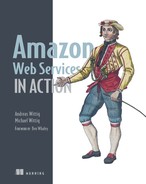About this Book
This book introduces the most important AWS services and how you can combine them to get the most out of Amazon Web Services. Most of our examples use typical web applications to demonstrate important points. We pay a lot of attention to security topics, so we followed the principle of “least privilege” in this book. And we used official AWS tools whenever possible.
Automation sneaks in throughout the book, so by the end you’ll be comfortable with using the automation tool CloudFormation to set up everything you’ve learned in an automated way; this will be one of the most important things you will learn from our book.
You’ll find three types of code listings in this book: Bash, JSON, and Node.js/JavaScript. We use Bash to create tiny scripts to interact with AWS in an automated way. JSON is used to describe infrastructure in a way that CloudFormation can understand. And we use the Node.js platform to create small applications in JavaScript when programming is required to use services.
We focus on Linux as the operating system for virtual servers in the book. Examples are based on open source software whenever possible.
Roadmap
Chapter 1 introduces cloud computing and AWS. You’ll learn about key concepts and basics, and you’ll create and set up your AWS account.
Chapter 2 brings Amazon Web Services into action. You’ll spin up and dive into a complex cloud infrastructure with ease.
Chapter 3 is about working with a virtual server. You’ll learn about the key concepts of EC2 services with the help of a handful of practical examples.
Chapter 4 presents different approaches to automating your infrastructure. You’ll learn how to use infrastructure as code by using three different approaches: your terminal, a programming language, and a tool called CloudFormation.
Chapter 5 introduces three different ways to deploy software to AWS. You’ll use each of the tools to deploy an application to AWS in an automated fashion.
Chapter 6 is about security. You’ll learn how to secure your system with private networks and firewalls. You’ll also learn how to protect your AWS account.
Chapter 7 introduces S3, a service offering object storage, and Glacier, a service offering long-term storage. You’ll learn how to integrate object storage into your applications to implement a stateless server by creating an image gallery.
Chapter 8 is about block-level storage for virtual servers offered by AWS. This is interesting if you plan to operate legacy software on block-level storage. You also take some performance measurements to get a good idea of the options available on AWS.
Chapter 9 introduces RDS, a service offering you managed relational database systems like PostgreSQL, MySQL, Oracle, and Microsoft SQL Server. If your applications use such a relational database system, this is an easy way to implement a stateless server architecture.
Chapter 10 introduces DynamoDB, a service offering a NoSQL database. You can integrate this NoSQL database into your applications to implement a stateless server. You’ll implement a to-do application in this chapter.
Chapter 11 lays the foundation for becoming independent of losing a single server or a complete data center. You’ll learn how to recover a single EC2 instance in the same or in another data center.
Chapter 12 introduces the concept of decoupling your system to increase reliability. You’ll learn how to use synchronous decoupling with the help of load balancers on AWS. Asynchronous decoupling is also part of this chapter; we explain how to use SQS, a distributed queuing service, to build a fault-tolerant system.
Chapter 13 shows you how to use many services you’ve learned about to build a fault-tolerant application. In this chapter, you’ll learn everything you need to design a fault-tolerant web application based on EC2 instances, which aren’t fault-tolerant by default.
Chapter 14 is all about flexibility. You’ll learn how to scale the capacity of your infrastructure based on a schedule or based on the current load of your system.
Code conventions and downloads
All source code in listings or in text is in a fixed-width font like this to separate it from ordinary text. Code annotations accompany many of the listings, highlighting important concepts. In some
cases, numbered bullets link to explanations that follow the listing, and sometimes we needed to break a line into two or
more to fit on the page. In our Bash code we used the continuation backslash. In our JSON and Node.js/ JavaScript code, an
artificial line break is indicated by this symbol: ![]() .
.
The code for the examples in this book is available for download from the publisher’s website at www.manning.com/books/amazon-web-services-in-action and from GitHub at https://github.com/AWSinAction/code.
Author Online
Purchase of Amazon Web Services in Action includes free access to a private web forum run by Manning Publications where you can make comments about the book, ask technical questions, and receive help from the authors and from other users. To access the forum and subscribe to it, point your web browser to www.manning.com/books/amazon-web-services-in-action. This page provides information on how to get on the forum once you’re registered, what kind of help is available, and the rules of conduct on the forum.
Manning’s commitment to our readers is to provide a venue where a meaningful dialog between individual readers and between readers and the authors can take place. It isn’t a commitment to any specific amount of participation on the part of the authors, whose contribution to the AO forum remains voluntary (and unpaid). We suggest you try asking the authors some challenging questions, lest their interest stray!
The AO forum and the archives of previous discussions will be accessible from the publisher’s website as long as the book is in print.
